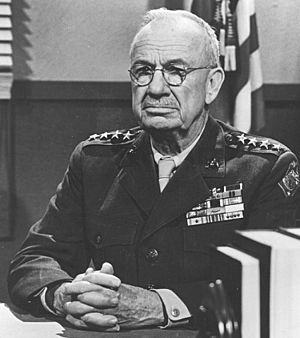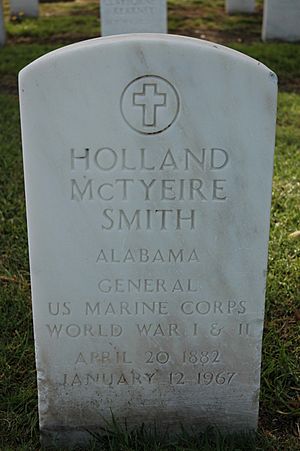Holland Smith facts for kids
Quick facts for kids
Holland Smith
|
|
|---|---|

General Holland M. Smith
|
|
| Birth name | Holland McTyeire Smith |
| Nickname(s) | "Howlin' Mad" Father of Modern Amphibious Warfare |
| Born | April 20, 1882 Seale, Alabama |
| Died | January 12, 1967 (aged 84) San Diego, California |
| Place of burial |
Fort Rosecrans National Cemetery
|
| Allegiance | |
| Service/ |
|
| Years of service | 1905–1946 |
| Rank | Four-star General |
| Commands held | Assistant Commandant of the Marine Corps 1st Marine Brigade 1st Marine Division V Amphibious Corps |
| Battles/wars | Philippine–American War Banana Wars World War I World War II |
| Awards | Navy Distinguished Service Medal (4) Purple Heart Medal Croix de Guerre |
Holland McTyeire "Howlin' Mad" Smith (April 20, 1882 – January 12, 1967) was a general in the United States Marine Corps during World War II. He is often called the "father" of modern U.S. amphibious warfare. This means he helped create the strategies for landing troops from ships onto enemy shores. His famous nickname, "Howlin' Mad" Smith, was given to him by his troops in the Dominican Republic in 1916.
Before World War II began, General Smith led important training for the Army, Navy, and Marine forces. This training focused on amphibious attacks, which means attacking from the sea. This was very important for successful U.S. landings in both the Atlantic and Pacific during the war. Later, he helped prepare U.S. Army and Canadian troops for landings in the Aleutian Islands. He then led the V Amphibious Corps in major battles like the Gilbert Islands, the Marshall Islands, Saipan, and Tinian in the Marianas.
During the Marianas operation, he commanded all the troops involved in the attacks. This included the forces that took back Guam. After that, he became the first commanding general of the Fleet Marine Force, Pacific. He also led Task Force 56, which included all the attack troops, during the fierce Battle of Iwo Jima.
Contents
Early Life and Military Start
Holland Smith was born on April 20, 1882, in Hatchechubbee, Alabama. His parents were John V. Smith and Cornelia Caroline McTyeire. He earned a science degree from Auburn University in 1901. He had already decided he wanted a military career. He was a first sergeant in the Alabama National Guard.
Even though he wanted to be a soldier, he first got a law degree from the University of Alabama in 1903. He worked as a lawyer in Montgomery, Alabama, for a year. Then, he joined the Marines as a second lieutenant on March 20, 1905. He later received an honorary law degree from Auburn University.
After training, Smith served in the Philippines from 1906 to 1908. He then had duties in places like Panama, Annapolis, Maryland, and San Diego, California. In 1914, he commanded a Marine unit on a ship in Asia. In 1916, he went to the Dominican Republic with the US 4th Marine Regiment. He fought in battles against local rebels there.
World War I Service
In May 1917, Holland Smith returned to the U.S. Just two weeks later, he sailed for France to fight in World War I. He commanded the 8th Machine Gun Company, part of the 5th Marines. His company trained with experienced French soldiers to learn war tactics.
Smith was chosen to attend the Army General Staff College in Langres, France. He graduated in February 1918, becoming one of only six Marines to complete this course. He then became the Adjutant (a senior administrative officer) for the 4th Marine Brigade. This brigade was part of the U.S. Army's 2nd Infantry Division.
During the famous Battle of Belleau Wood, Smith was a key liaison officer. He made sure that different parts of the brigade could communicate with each other. In July 1918, he moved to the US I Corps. He helped plan and manage operations during major battles like the Aisne-Marne Offensive and the Meuse–Argonne offensive. In November 1918, he was promoted to major.
After the war ended, Smith marched with the troops through Belgium and Luxembourg to the Rhine River. He then served with the U.S. Army's General Staff during the occupation of Germany.
For his brave service at Belleau Wood, the French government gave him the Croix de Guerre. He also received a special commendation from General John J. Pershing. This led to him being awarded the Purple Heart in 1932, one of the first given for merit.
Between the World Wars
Smith returned to the United States in April 1919. For the next few years, he worked in various roles. He studied at the Naval War College in Newport, Rhode Island. He also worked in Washington, D.C., helping to plan naval operations. He was the first Marine officer to serve on the Joint Army-Navy Planning Committee.
He served on battleships like the Wyoming and Arkansas. In 1924, he went to Haiti on expeditionary duty. He helped with operations and training for the Marine Brigade there. Later, he was chief of staff for the 1st Marine Brigade at Quantico, Virginia.
From 1931 to 1933, he served on the USS California. He then commanded the Marine barracks at the Washington Navy Yard. From 1935 to 1937, he was chief of staff for the Pacific Department in San Francisco, California. In March 1937, he moved to Marine Corps Headquarters. He became the director of the Division of Operations and Training.
From April to September 1939, Smith was the assistant commandant of the Marine Corps. During this time, he was promoted to brigadier general.
World War II Leadership
General Smith then took command of the 1st Marine Brigade at Quantico. In October 1940, he took this unit to Guantanamo Bay, Cuba. There, they trained extensively in amphibious warfare. In February 1941, his brigade became the U.S. 1st Marine Division, and he was its first commander.
In June 1941, he took command of a new organization. This group eventually became the Amphibious Force, Atlantic Fleet. Under his leadership, the 1st Marine Division and two Army divisions (the 1st and 9th) received their first training in how to attack from the sea. Smith was promoted to major general in October 1941.
In August 1942, General Smith moved to San Diego. He took command of the Amphibious Corps, Pacific Fleet. Here, he trained the 2nd and 3rd Marine Divisions before they went overseas. He also trained the 7th Army Division for the Aleutian Islands operation.
His unit was later renamed the V Amphibious Corps. In September 1943, Smith led this corps to Pearl Harbor. There, they began planning for the Gilbert and Marshall Islands campaign. He was promoted to lieutenant general in February 1944. He continued to lead the V Amphibious Corps until August 1944. Then, he became the commanding general of the Fleet Marine Force, Pacific, at Pearl Harbor.
He also commanded Task Force 56 during the fierce Battle of Iwo Jima. He famously said, "In our corps without responsibility and discipline we would not have won the Battle of Iwo Jima." After the battle, he returned to the U.S. in July 1945. He then led the Marine Training and Replacement Command in California.
When planning the 1945 Battle of Okinawa, U.S. Navy Admirals Raymond Spruance and Richmond Turner wanted Smith to lead the invasion. However, Admiral Chester Nimitz, the commander in chief of Pacific Forces, disagreed. This was because Smith had removed a U.S. Army general, Ralph C. Smith, during the Battle of Saipan. There was some tension between the Army and Marine leaders because of this. So, U.S. Army General Simon Bolivar Buckner, Jr. was chosen to command the Okinawa invasion instead.
Retirement and Legacy
Holland Smith retired from the Marine Corps on May 15, 1946. He was promoted to general on the retired list because of his outstanding service in combat. The 64-year-old general moved to La Jolla, California. He enjoyed his hobby of gardening there.
Smith's wife, Ada B. Wilkinson, passed away in 1962. After a long illness, Holland Smith died on January 12, 1967, at the U.S. Naval Hospital in San Diego, California. He was 84 years old. His funeral was held with full military honors. He was buried in Fort Rosecrans National Cemetery, which overlooks San Diego harbor. Smith was survived by his son, Rear Admiral John V. Smith.
Military Awards and Honors
General Smith received many important military awards for his service. These included the Navy Distinguished Service Medal multiple times and the Purple Heart. He also received the Croix de Guerre from the French government.
Camp H. M. Smith, a Marine Corps base on Oahu, Hawaii, is named after him. It is an important base for the Pacific Command. There are also two Marine Corps League groups named in his honor:
- Detachment #93 – Howlin Mad – Hobart, Indiana
- Detachment #592 – Howlin' Mad Smith – Birmingham, Alabama
In the movie Flags of Our Fathers, General Smith is played by actor Gordon Clapp. In 1964, Smith received the Golden Plate Award from the American Academy of Achievement.
See also
 In Spanish: Holland Smith para niños
In Spanish: Holland Smith para niños
- List of 1st Marine Division commanders
- Battle of Tarawa
- Battle of Saipan




